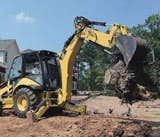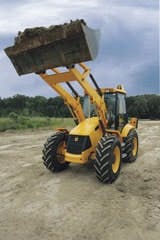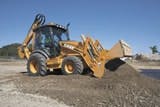As the newest additions to the Case backhoe loader line, the 580 Super M Plus Series 3 and 590 Super M Plus Series 3 have variable-volume hydraulics, “which gives you fuel efficiency and a hydraulics-on-demand type of system,” says Jim Hughes, brand marketing manager, “and we’ve coupled that with our pilot controls.”
The backhoe loader has undoubtedly more challengers in the utility equipment game today, but rumors of its demise? Those are greatly exaggerated, say backhoe loader manufacturers. More to the point, those OEMs appear focused on product enhancements that will retain, even recapture, product market share.
“Manufacturers are starting to look at why a mini-excavator is so much better at digging a trench than a backhoe; why it’s so much more efficient; and down the road what’s going to happen with that in mind is that they will be using some of the characteristics of the mini-excavators in the backhoes . . . and taking from loaders and skid steers on the front end as well,” says Jim Blower, mid-range product marketing manager with JCB. “To try to claw back some of that business, as it were,” look for the multitasking characteristics of a machine that already carries two product names to be accentuated even more.
“Over the years, the backhoe’s always been the machine you’d bring onto a site and do every job with it,” says Blower, adding that over the past 10 to 15 years, skid steers, compact wheel loaders and excavators have dug their way into that market. “If a guy just typically wants to dig a pipeline trench, he’s going to put an excavator in there, because it does it a little bit more efficiently.
“Nowadays, in the last five years or so, the backhoe is still being seen as this multi-tasking tool that you put on the jobsite at the beginning and it’s the last thing to leave, because it can do so many odd jobs around the site. You’re not typically seeing it in the true production situation, but you are seeing it doing lots and lots of different odd jobs around the jobsite.”
At John Deere, Bob Tyler agrees, and sees an opportunity for full-sized combination backhoe loaders — those competing in the 14-foot dig-depth class and above.
“You’ll hear every so often folks talk about substitution of backhoes; in other words, mini-excavators and skid steers taking over from backhoes,” says Tyler, John Deere product marketing manager for backhoe loaders. “One of the reasons skid steers have become popular is because of the versatility. They have all these attachments that they can put on the front, and you can use the one machine for multiple tasks. And now we’re just doing exactly the same thing with the backhoe, so that you can use that one machine for multiple tasks. Of course, with the backhoe the advantage is you’ve not only got the front; you’ve got a back end that you can do the same thing with.”
In North America, the front end of the backhoe loader has been a bit of a mystery to equipment users, judging by its historical use — or lack of.
“We’ve recently done a study on exactly that,” says JCB’s Blower. “Everyone had the typical thought of 60/40, with 60 percent being the back and 40 percent being the front, but in actual fact it’s more like 85 percent in back-end use. In Europe, it’s more of a 60/40 split, but also thrown in there is that Europeans road these machines a lot more than typically people in America do. These things will easily spend three or four hours on the road getting to the next job in Europe. It’s just a lot cheaper to drive it there than it is to put a truck under it and get it to the next jobsite.”
In Tyler’s view, John Deere has tackled the front-end challenge with the introduction of the TMC Tool Carrier option on top of the Total Machine Control (TMC) option now available on the 14-foot-class 310SJ and 15-foot-class 410J backhoe loader models.
“For years with backhoes, you could put a hydraulic quick coupler on the front, so you could drop your bucket off and put the forks on. Well, that doesn’t make it a tool carrier; that makes it a backhoe with a coupler on the front of it,” he says. “The part that truly makes it a tool carrier is that it has parallel lift.”
Deere’s TMC Tool Carrier allows the addition of a couple of features established on four-wheel-drive loaders — return to carry and boom height kick-out — further utilizing the loader end of the backhoe loader product, says Tyler.
Particularly useful whenever a loading cycle is involved, Case Construction Equipment now offers Comfort Steer on all five of its backhoe loader models, including the all-new, wider 580 Super M Plus Series 3 and 590 Super M Plus Series 3 machines featuring variable-volume, closed-center hydraulics.
“Normally on a backhoe when you’re turning the steering wheel, it takes you about three to three-and-a-half times around in a full circle to get from full lock left to full lock right,” says Jim Hughes, brand marketing manager with Case Construction Equipment. “When you have the Comfort Steer engaged, it only takes one-and-a-half, so it cuts the work in half. Imagine you’re doing trench work: You’ve dug your trench, and you laid your pipe or done whatever you had to do in there, and now you have to go in and backfill the trench using the loader bucket. If you can cut the number of times you have to turn that steering wheel in half, what do you think that’s going to do for operators?
“When the operator doesn’t have to work as hard and can be more productive, what’s that doing? It’s putting money in his pocket. The longer it takes him to do the job, the less money he’s getting paid.”
Backhoe loaders with brains?
The backhoe loader may be a run-around, do-it-all type of machine, but that doesn’t mean it can’t work smartly, too, according to Caterpillar.
The AccuGrade machine control and guidance system is now available direct from the factory for the Caterpillar 416E, 420E and 430E backhoe loader models. “The machine has everything on it, programmed, ready to run, when it shows up,” says Paul Grohsmeyer, Caterpillar backhoe loader sales and marketing. “All of the sensors on the machine are basically built into the cylinders, so that they are protected. They are not an add-on to the system. By having them inside the cylinders, they’re pretty well bomb-proof.”
Two AccuGrade options are available. The site reference system is an entry-level grade and depth check system allowing the operator to excavate to pre-determined coordinates. The laser reference system uses an off-board laser transmitter to set a grade reference over an entire work area.
“By doing it the way we have done it, it’s ingrained into the machine, so we know exactly what the machine is doing. You don’t have to worry about the operator having to go back and re-measure things,” says Grohsmeyer. “When the machine leaves the factory with the basic system on it, every Caterpillar backhoe bucket for that model line is already programmed in. So if the operator wants to change from a small-capacity bucket, to a soil-excavation bucket, to a high-capacity bucket, all he has to do is go to a screen and select the bucket. All the measurements are already taken for him; it’s already saved onboard the machine, and he doesn’t have to worry about doing any measuring himself.
“The aftermarket systems if you will, as good as they may be, still rely on the operator making those measurements and making the changes onboard the machine.”
Along with the operator comfort of having the joystick controls mounted in the armrests, Deere’s TMC option on the 310SJ and 410J models features three hydraulic speed modes — high, normal and precision. The high production mode is 20 percent faster than normal, whereas precision works at 60 percent of normal speed, which actually leads to “subtle” production gains, says Tyler. “That’s really useful for working around underground buried utilities, and you can imagine production can actually go up if you do that, because if you actually hit that underground utility because you were digging too fast, your production stops.” Similarly, he adds, when craning a load, a backhoe arm moving too fast leads to excessive load swing . . . and excessive waiting for the ground crew.
While the North American market continues to evaluate how it uses backhoe loaders, one manufacturer has moved away from a continental-unique designation to the adoption here of its worldwide nomenclature. Gone are the 200 Series of JCB models in exchange for the 3C, 3CX and four-wheel-steer 4CX product families of J.C. Bamford.
“It’s history,” says Blower. “Mr. JCB started off with the JCB 1, and then he went to the JCB 2, then up to a JCB 3. For the next step, he didn’t actually change the whole machine; he just did little changes, so it became a 3B, then it became a 3C, and then he invented extra dig, and hence the name 3CX.
“We decided that we needed to call the same machine the same thing all over the world.”
How various parts of the world view the same piece of equipment may, indeed, be coming together.







